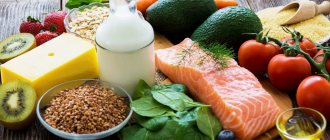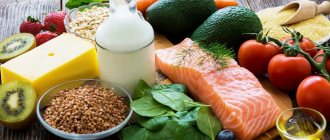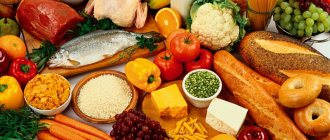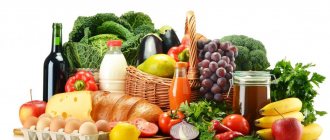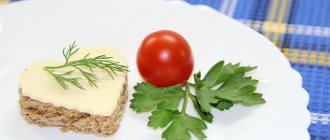In this article we will tell you:
- The concept of rational nutrition
- Basics of rational nutrition
- Rules for rational nutrition
- Rational diet
- Children's nutrition
- Rational nutrition standards
- Energy value of food
- Recommendations for a balanced diet
It has long been known that the primary role in ensuring the quality of our life is not played by genetics (although its influence, undoubtedly, cannot be denied), but rather by our image and style of behavior, as well as eating habits. Not only the functioning of our single integral system called the body, but also the health of subsequent generations will largely depend on how we eat.
Reproductive, hormonal, digestive - there are still no systems on which diet would not have a significant impact: just as the hands of a dial describe the same circles, so everything invariably revolves around what we put in our diet and in what quantity. mouth.
But how not to force yourself into the framework of prohibitions and conventions - in fact, do those same standards of healthy eating exist? How not to chop wood on the way to creating a rational diet and, instead of the expected super effect in the form of toned, elastic skin, beautiful relief and the absence of fatty spaniel ears hanging from the sides, not to aggravate existing problems? Let's figure it out.
The concept of rational nutrition
Balanced diet
- This is not a simple diet balanced in micro- and macronutrients. This is a complete diet that satisfies all the body’s energy needs, tailored to meet age and gender characteristics, the presence of chronic or concomitant diseases, genetic disorders and enzymopathies.
This concept cannot be specified - it always remains purely individual in relation to each person. After all, what is “rational” for one patient may not only not be suitable, but also be extremely dangerous for another: for example, although a 3-times-a-day diet is considered the most physiological, it is fundamentally unsuitable for a patient with adrenal depletion, not not to mention the extreme manifestation of this condition - Addison's disease.
In addition, genetics is also important: for example, the presence of defects in the genes of the folate cycle entails a violation of the utilization of the well-known and quite sensational amino acid homocysteine - and such people are advised to limit animal products containing a precursor in the reactions of its synthesis.
On the other hand, a purely plant-based diet is also contraindicated in case of polymorphisms in other genes - in this situation, vegetarians and vegans are at risk not only for vitamin B12 deficiency, but also for many others. So, say, if the transition of carotene, a precursor of vitamin A, which is concentrated in plant products, is disrupted, you can eat a kilogram of carrots - but this will be of little use (at least in the context of the formation of retinol).
Basics of rational nutrition
And yet we will have to start with theory: after all, it is important to understand not only what we eat, but also for what purpose we do it.
There must be balance in all processes of our body - after all, it is towards internal homeostasis that it so tirelessly strives throughout its life. Let's call this a lever or driving force, which forces the activation of the synthesis of certain hormones and at the same time reduce the formation of others (for example, with an increase in the concentration of glucose in the blood, insulin is actively produced by the beta cells of the pancreas, while the conductor coordinating this hectic metabolic orchestra sends a clear signal: stop glucagon production). Entering the body, crossing its borders in the form of barriers of the skin and mucous membranes stimulates a reciprocal immune response - and all because our smart body, in fact, craves one main goal: peace and order on its vascular streets with parenchymal houses.
Nutrition is no exception.
— the rule of balance is unchanged for him. We eat in order to live (although statistics in recent years indicate a completely opposite trend of interpretation) - in other words, the amount of incoming food products, which, after splitting and digestion, are burned in the furnaces of cells, forming energy, must fully satisfy the body’s expenses, and they really huge.
Few people have thought that most processes, no matter how disadvantageous it is for the body, occur with a loss of energy - even such a primitive mechanism as the transport of glucose, perhaps the most common nutrient: given the large size of its molecule, it simply will not pass through the cage gate, getting stuck in the doorway. Unfortunately, this carbohydrate cannot carry out its functions in the blood - therefore, specific carriers come to the rescue, carrying or transporting it into the cells on their shoulders, thereby providing them with the necessary raw materials.
Fat-soluble substances and gases can freely penetrate through the lipid layer of the membrane - but we cannot eat only them! So, energy is the basis of everything.
However, what will happen if we receive more energy than we are able to expend? Considering the greed of our body and its desire to accumulate (who knows when that very rainy day will come), the balance will invariably be shifted - the so-called positive energy balance develops. And then everything follows the well-worn scenario: depositing fatty tissue as a safety net in case of an apocalypse.
The balance of nutrients is no less important: in classical dietetics the following ratio is given for proteins, fats and carbohydrates - 1: 1: 4. Although, we emphasize: in many ways, these numbers will depend on age and the chosen diet.
The diet should be varied
: mono-diets are a thing of the past. The more sources of nutrients, vitamins and minerals, the more likely it is that the body will be in minimal deficiency states. Turn your plates into a rainbow of colors - typically brightly colored fruits and vegetables are not only a great source of fibre, but also contain quite a bit of antioxidants. In addition, digestion begins even before the first bite enters the oral cavity and the subsequent irritation of the taste buds: that is why the appearance of the dish, its smell and table setting are so important. The complex reflex phase of secretion is the initial link that should not be excluded from the chain of digestion and absorption.
Drink enough water
- no matter how banal this rule may sound, in practice it turns out that many happily neglect it. Water is the basis of life: most digestive secretions consist of more than 97% of it. In the composition of blood plasma, water accounts for 91 to 93% - impressive, right?
Often, restriction in water consumption is motivated by the occurrence of edema. Here it is important to dig deeper and find the main reason for their appearance: and it is clearly not connected (directly so exactly) with water. Pay attention to possible endocrine pathologies - in particular, the functioning of the thyroid gland and adrenal glands. Sometimes the cause is disorders of the cardiovascular system.
Try to drink at least one glass immediately after waking up - and then just start brewing coffee. Moreover, its temperature should be equal to room temperature - remember that excessively cold temperatures can sufficiently cause spasms and generally disrupt the functioning of the gastrointestinal tract.
An approximate formula for calculating the daily water requirement:
Weight (in kg) *30 (ml)
Rules for choosing a diet:
- Calorie counting. It is necessary to consume foods with optimal energy value so that there is a correct ratio between energy intake and energy expenditure.
- It is always necessary to study the chemical composition of products. It should include vitamins, macro- and microelements, and other beneficial substances.
- Proteins, fats and carbohydrates must enter the body in the right ratio. Proteins take up 20% of the diet, fats – 30%, and carbohydrates – 50%.
- The food entering the body should be varied. You cannot eat the same food for several days in a row; such food will not bring the desired benefits.
- A meal schedule is required. Food must enter the body at a certain frequency. It is recommended to eat 5 meals per day, in small portions. Thus, the body's metabolic processes will improve.
With healthy eating you can achieve your goals. It is always necessary to remember that every modern person has an individual body and the same rules cannot be applied to everyone. Moreover, all people have different motivations to eat right, and this must be taken into account when planning their diet.
For example, a weightlifter's goal may be to increase muscle mass, so the diet should be high in calories. The incoming energy should be enough for intense physical activity throughout the day.
In many ways, the energy value of the diet depends on the weight of the athlete and the type of sport he practices.
If a person’s goal is to lose weight, then it is worth making sure that:
- There was a relatively low calorie content of the incoming food.
- The correct number of meals and a rational pause between them were observed.
- The food was carefully selected to be healthy and easy to digest.
- The body received enough fluid. This is an important aspect for good digestive function.
It is important that proper nutrition allows you to improve your figure, improve your overall health, productivity and mood.
Rational diet
- Breakfast is everything.
Your first meal should be balanced, rich in fat and protein - this combination will make you full, and you won't even remember about food until lunch.
At the same time, the usual cereals, fruit juices, croissants and other confectionery products, except for another nuclear attack against the cells of the pancreas, will bring neither benefit nor saturation. In a word, a complete sugar bomb.
We recommend
“Balanced nutrition: the right diet and the right foods” Read more
We recommend considering the options for keto breakfasts: they ideally satisfy the feeling of hunger and do not just pickle the worm, but actually put it into a state of suspended animation. Use avocado, bacon, olives, cod liver, and eggs, salmon or poultry are great sources of protein. Add unsweetened coffee or cocoa and a small cup of your favorite berries - and you are guaranteed a stable emotional background, the key to which is the absence of hypoglycemia swings.
- Forget about the existence of the food pyramid
- at least until it is revised. Or better yet, create a new one!
What do you think occupies a dominant position in the old one? Surprisingly, these are grain crops.
Undoubtedly, the same cereals have many useful properties, but let's be honest: in the realities of the modern world, people are surrounded (literally) by their abundance. Take the same wheat (or rather its proteins - gliadins, which, together with other proteins similar in structure and functions, are united under the general name “gluten”) - wherever its components are added - the spectrum has long ceased to be limited to bakery products. The widespread use of gluten has also led to a predictable result: more and more, various groups of the population are diagnosed with gluten hypersensitivity - both in adults and in children.
Food hygiene, that branch of science that a priori should move ahead along with various advanced technologies, is stuck in a deep and very ancient hole of the past. But the responsibility for your health still lies not so much on the shoulders of science, but on your own.
- Fractional meals
- the same outdated regime, applicable only to professional athletes and in a number of diseases. A healthy person, and even more so a person striving with all his might to lose weight, should completely forget about snacks - as an adaptation during a smooth transition, you can leave one, but with the condition that it will be fatty.
- Avoid eating fruit as a meal on its own
— the fructose they contain bypasses all saturation pathways (this is achieved, in particular, due to the absence of a response signal to its entry in the form of insulin secretion from the pancreas). That is why it will not only not dull the feeling of hunger, but, like a match falling on a stack of dry firewood, will make it flare up with even greater force.
- Try to eat at certain times
- again, the digestion process does not rely on purely mechanical rubbing and absorption of food in the gastrointestinal tract.
Balanced nutrition - what is it?
Constantly, throughout our lives, several times a day, each of us introduces into our bodies a huge range of chemicals in food. The complex and finely balanced digestive system processes this material, selecting what is needed and removing what is not needed, creating compounds from food products that are necessary for the body. Figuratively speaking, the “menu for the table” is transformed into a “menu for the body.” The performance, mood, health, results and physical fitness of a person depend on how well one menu corresponds to another, how correctly the products are selected and the nutrition is organized.
Having mastered “fashionable” diets, taking advice from astrologers and “clairvoyants,” some people completely do not understand the principles of rational nutrition. The advice of some overly “enthusiastic” specialists who promote their proposed approaches to nutrition is very contradictory, to the detriment of objectively existing norms, and sometimes even common sense.
In recent years, the theories of vegetarianism, raw food diet, fasting, etc. have revived and become fashionable. Works have appeared whose authors insist on limiting the consumption of fats and carbohydrates, advise abandoning the use of milk, meat and eggs, recommend vegetables and rice as the main food, and propose radical reduce the calorie content of the daily diet (up to 1000 kcal and below). Some authors extol fasting as a means of physical and mental improvement, others criticize mixed nutrition, justify the usefulness of separate intake of foods, etc. Are these approaches justified when organizing nutrition for healthy people? Obviously, these nutritional plans can be used to achieve specific results over short periods of time.
Basically, the nutrition of any healthy person should correspond to the individual characteristics of the body. Therefore, it is necessary to know the principles of healthy eating.
1. Law of energy adequacy
In order to blink an eye, take a breath, lift a finger or move a computer mouse, energy is required to perform any action. Even when you lie down and do nothing, energy is spent on breathing, the work of the heart and other internal organs. The source of energy for the body is food. Therefore, the amount of energy entering the body with food must correspond to the amount of energy expended by the body. The first law of rational nutrition is the law of energy adequacy.
Let's compare the formation of our body to the construction of a house. In accordance with the first law of rational nutrition, to build a building (organism) you need a sufficient amount of energy and material. It is also necessary to further maintain the body in normal condition. Energy requirements depend on age, gender, body weight and other factors. With insufficient nutrition, the functional, adaptive, and protective capabilities of the body decrease. To meet energy needs, the body begins to use muscle proteins, which naturally weakens the person. A more pronounced energy deficiency leads to weight loss, the development of dystrophy, edema, and nutritional insanity (dementia). Excessive nutrition contributes to an increase in body weight and related diseases (diabetes mellitus, atherosclerosis, malignant neoplasms, cholecystitis, etc.)
2. Law of plastic adequacy
Continuing the comparison with building a house, the total amount of materials and energy is not everything. It is unlikely that it will be possible to build a good building if all the material consists only of sand or wood. Obviously, an appropriate selection of substances is needed. The second law of rational nutrition is the law of plastic adequacy. Food components must be supplied in certain balanced quantities that meet the body's needs. The diet must contain proteins, fats, carbohydrates, vitamins, minerals (macro- and microelements), water necessary for the formation and renewal of cells and tissues.
There are precise recommendations regarding the amount and ratio of various chemicals in the diet, tables and reference books from which calculations can be made. This is a precise but difficult path. Nutritionists give a simple recommendation: the diet should be varied.
It is clear that depending on your goals and lifestyle, certain foods may predominate, but a complete exclusion from the diet, for example, of fats or vegetables, can cause significant damage to health. In addition, even the most delicious dish becomes boring if you eat it for a week in a row. The diet should include foods from all major groups: grains (including bread), meat, fish, eggs, vegetables, fruits, fats, dairy products.
3. Law of enzymatic (enzyme) adequacy
However, it happens that a food product contains the necessary components and has beneficial qualities, but causes painful reactions in humans (nausea, vomiting, rash). Some people cannot drink milk, others do not tolerate fish well, others do not tolerate mayonnaise, etc. Digestion is a complex process in which many biological catalysts ("accelerators" of biochemical reactions) - enzymes - are involved. So, if there is a malfunction in the operation of a complex “conveyor” of enzymes, one of them is missing or its activity is sharply reduced, disorders called enzymopathies are possible. For example, milk intolerance is most often associated with impaired hydrolysis (breakdown) of lactose (milk sugar) as a result of a defect in the enzyme betagalactosidase. Thus, the chemical composition of food must correspond to the enzymatic systems of the body. This is the third law of rational nutrition - the law of enzymatic (enzyme) adequacy.
No matter how ideal a food product may be in all respects, if the body does not have the necessary set of enzymes, it will not be digested. In addition, this law implies the need to be very careful when switching to new diets and nutrition systems. In such cases, the complex of enzymes involved in digestion, adapted to the usual nature of nutrition, will have to be rearranged, which, with sudden changes, can lead to undesirable consequences. When fasting or sharply limiting the amount of food (for example, in order to lose weight), the production of digestive juices and the activity of the digestive system are also significantly reduced. Therefore, it is necessary to adhere to the principles of gradualism and careful treatment of the gastrointestinal tract when leaving such diets.
Continuing the comparison with building a house, we can say that in addition to energy, a sufficient amount of varied and high-quality materials, appropriate tools are needed in order to properly process the materials. How to implement this law? Our advice is quite simple.
Listen to your body. If a food causes you to have a painful reaction, you should eliminate it from your diet, no matter how tasty it looks or how much you want to eat it. If you change your usual diet, do it gradually and carefully. It is useful to keep a food diary and avoid consuming those foods and their combinations that cause undesirable reactions, making maximum use of other products, the use of which gives the most noticeable positive results.
4. Law of biotic adequacy
The cause of painful reactions can be not only the absence or defect of digestive enzymes, but also the presence in food of foreign substances harmful to the body: pesticides, heavy metals, nitrites and nitrates, synthetic chemical compounds, etc. Of course, we must strive to ensure that There were no such substances, but in modern conditions this is not easy to achieve.
In accordance with the fourth law - the law of biotic adequacy of nutrition - food must be harmless and not introduce substances alien to it into the internal environment of the body. No one wants the walls of their house to be covered with paint that releases toxic substances, or the water pipes to contaminate their drinking water. Try to use environmentally friendly products. Carefully study the composition of the components indicated on the packages. Pay attention to the color, consistency, and smell of the products. Avoid anything that is unnatural.
5. Law of adherence to food intake
And the last, fifth law - follow the eating schedule. This regime should correspond to your biological rhythms and social characteristics of life. It is difficult to give recommendations that are suitable for everyone. There are people who are “morning people,” who are especially active in the morning, and people who are “night owls,” who are more energetic in the evening and at night. Some people work the first shift, others the second or third. You should take all this into account and develop a regime that is most suitable for you. Nevertheless, based on extensive experience and observations, general principles of a rational diet have been formulated:
- fractional meals (at least 4 times a day);
- eating at the same hours;
- the duration of the intervals between meals is no more than 6 hours;
- eating no earlier than 30-40 minutes later. after physical activity;
- dinner at least 2-3 hours before bedtime.
Compliance with the laws of healthy nutrition is the basis on which the entire system of rational nutrition should be based.
***
In conclusion, a few words about losing weight. Many people set this goal for themselves; Many books have been written on this issue. I just want to give some tips and draw attention to the most common mistakes:
- You need to lose weight slowly. According to WHO recommendations - no more than 3 kg. per month, that is, 100 g per day. The body must have time to adapt. Otherwise, the skin will become flabby, since it will not have time to contract following the rapidly decreasing volume of subcutaneous fatty tissue and muscles. Disturbances in the functioning of other organs and systems are possible (remember the third law of rational nutrition).
- The calorie content of the diet should not be less than the basal metabolism, that is, 1400-1700 kcal (per day).
- When reducing the caloric content of food intake, it is necessary to increase physical activity.
- When reducing the caloric content of the diet, in no case should you reduce the consumption of essential nutrients: complete proteins, vitamins, minerals, polyunsaturated fatty acids. Otherwise, there will be a sharp decrease in the rate of metabolic processes in the body, which will contribute to the preservation of fat reserves. Reducing the calorie content of the diet should occur by reducing the consumption of animal fats and carbohydrates, primarily refined ones - sugar, confectionery, and premium flour products.
I would like to note once again that you need to approach various selective, monotonous fasting diets very carefully. The diet should be varied and include all essential nutrients. Otherwise, the risk of injury and the development of diseases increases sharply, and instead of recovery, you may end up with serious health problems. Don't fall for advertising tricks and be attentive to your health.
Dietitian, Novopolotsk City Hospital
Pavlovskaya T.G.
Children's nutrition
Rational nutrition is no less important for children - especially in the context of treatment and prevention of diseases, maintaining optimal conditions for the growth and development of the child, in the maturation and final differentiation of tissues and systems of his body.
An adequate supply of minerals is necessary - their deficiency has a huge range of multidirectional adverse factors on the cognitive functions, growth and processes of development of the child as a person. For example, a lack of iron, leading to hypoxia or oxygen starvation, reduces the activity of liver enzyme systems (and this is subject to their already inadequate activity), and also slows down the processes of cell division. In addition, the exchange of serotonin, dopamine, and other neurotransmitters is also inhibited.
Study
: Micronutrients for child growth and development
Iodine deficiency, which is widespread, leads to disorders of cartilage tissue, slows down skeletal growth and impairs its maturation. A decrease in the activity of the thyroid gland is also accompanied - for example, insufficient formation of such a hormone as triiodothyronine (T3) inhibits the division of nerve cells (or rather their precursors), and the process of myelination of nerve fibers is disrupted.
In general, it is recommended to eat three meals a day and two additional snacks. At the same time, the latter also need to be made as healthy as possible - replace sweets and chocolate with low-carb homemade sweets, berries and nuts.
Remember
: instilling correct eating habits in childhood is much easier than getting rid of them in adulthood (the neural connections are already formed).
Rational nutrition standards
In general, any balanced diet should contain
:
- Protein sources
: meat, eggs, fish, seafood, legumes (remember the need to pre-soak them).
Perfect fit
:
- Salmon (32 g/100 g product)
- Beef (28 g/100 g product)
- Chicken (25 g/100 g product)
- Rabbit meat (23 g/100 g product)
- Shrimp (20 g/100 g product)
- Squid (17 g/100 g product))
- Eggs (12g/100g product)
- Sources of fiber
: vegetables, fruits, berries, herbs, cereals, nuts.
- Sources of healthy fats and omega-3 polyunsaturated fatty acids
. Fatty fish (herring, trout, mackerel) will also help with this.
- It is recommended to add probiotic-rich foods
- sauerkraut and other fermentation products. It’s not for nothing that the answer to the main (after Shakespeare’s “to be or not to be”) question has not been received: do we control the microbiome or does it control us?
Healthy nutrition and bakery products
24.06.2019
Rational nutrition is nutrition that is sufficient in quantity and complete in quality, satisfying the energy, plastic and other needs of the body and providing the necessary level of metabolism. Rational nutrition is based on gender, age, nature of work, climatic conditions, national and individual characteristics.
Principles of rational nutrition:
1) compliance of the energy value of food entering the human body with its energy expenditure;
2) the intake of a certain amount of nutrients into the body in optimal proportions;
3) correct diet;
4) variety of food products consumed;
5) moderation in food.
The adverse consequences of excess nutrition against the background of low physical activity suggest that one of the basic principles of rational nutrition during intellectual work should be a decrease in the energy value of food to the level of energy expenditure or an increase in physical activity to the level of calorie content of food consumed.
According to the balanced nutrition formula, the ratio of proteins, fats and carbohydrates is 1: 1: 4, while the amount of proteins in the diet should be 11-13% of the daily diet, fats - on average 33%, carbohydrates - about 55%.
Sources of nutrients are food products of animal and plant origin, which are conventionally divided into several main groups.
— the first group includes milk and dairy products (cottage cheese, cheeses, kefir, yogurt, acidophilus, cream, etc.);
- second - meat, poultry, fish, eggs and products made from them;
- third - bakery, pasta and confectionery products, cereals, sugar, potatoes;
- fourth - fats;
- fifth - vegetables, fruits, berries, greens;
- sixth - spices, tea, coffee and cocoa.
Each group of products, being unique in its composition, is involved in the primary supply of certain substances to the body. Therefore, one of the basic rules of balanced nutrition is variety.
Bread is the main product of the daily human diet, since it has high nutritional value and provides the body with complex carbohydrates (starch, dietary fiber), proteins, vitamins (B1, B2, B6, PP, E, folates), magnesium, and iron.
A person who spends 2500 kcal per day needs to include 320 g of various types of bread in his diet every day, which is approximately equal to eight standard pieces.
The quality of bread directly depends on the characteristics of flour and other components of the recipe, compliance with technological regulations and storage conditions. An increase in humidity, an increase in acidity and a decrease in porosity worsen not only the organoleptic characteristics of bread, but also its digestibility and the degree of absorption of nutrients.
Bread, as a rule, does not serve as a medium for the development and reproduction of microorganisms that can cause food poisoning. At the same time, there are several forms of microbiological spoilage of bread, which are grounds for excluding its use in food: molding, potato disease, damage by pigment-forming bacteria.
The development of mold fungi occurs with increased humidity of bread and is accompanied not only by a deterioration in its appearance, but also by the appearance of an unpleasant odor and the accumulation of toxic compounds.
Potato (sticky) disease occurs as a result of the development of spore-bearing bacteria in the crumb, which are widespread in the environment. Potato disease affects only wheat bread, characterized by high humidity and low acidity, if it is improperly stored (high temperature, poor ventilation) in the summer. The crumb of affected bread is a sticky, viscous, dirty-brown mass with the smell of rotting fruit.
Bread affected by the above microorganisms is considered unfit for food and must be technically processed or disposed of.
Prevention of damage to bread by spoilage microorganisms consists of strict adherence to technological production regulations and sanitary conditions for storing bread. In order to prevent the occurrence of potato disease of bread, it is necessary to wash bread storage shelves at least once a week with warm water and detergents, wipe with a 1% solution of acetic acid and then dry.
Thus, rational nutrition is not only a properly organized and timely supply of nutrients and substances to the body, but also the use of high-quality and safe products.
Be healthy!
Energy value of food
Energy value of food
- an indicator that displays the amount of energy released by the body when absorbing incoming products. This is calorie content.
The energy value for different classes of biological compounds is different:
- Fats - 9.29 kcal/g.
- Proteins - 4.1 kcal/g.
- Carbohydrates - 4.1 kcal/g.
Even without going into biochemical reactions, it is already clear from these data that the most advantageous source of energy - that is, the fuel on which the cellular engines operate - is the oxidation of fats. Thus, when burned, they contribute to the release of twice as much energy as other classes of organic compounds.
However, in fairness, it is worth noting that not all cells are capable of recycling them. So, let’s say, red blood cells, which simply lack those very production furnaces called “mitochondria,” simply cannot oxidize fatty acids.
Recommendations for a balanced diet
- Don't rely entirely on apps that calculate your calories.
foods you eat: remember that they work quite subjectively, using average values. It is much more important to provide adequate physical activity, which would reinforce and complement the results of proper nutrition.
- Don't create red lists or taboos
: there is a high probability of failure. A balanced diet should become a way of life for you, and not just another hard labor in the form of a short-term diet.
- Try to personalize your diet
- especially in the presence of pathologies from various organs and systems. Contact specialists in the field of nutrition: they will help you not only compensate for deficiencies (if any), but also choose the right course and stick to it in the future.
Remember
: Your health is only in your hands!
Healthy nutrition menu
The first day
| Breakfast | Omelet in melted butter GHI with cherry tomatoes and aged cheese; leafy vegetables; unsweetened apple or pear. |
| Dinner | Creamy cauliflower soup, baked salmon; vegetable salad. |
| Dinner | Mixed grilled vegetable salad. |
Second day
| Breakfast | Casserole using coconut flour and soft cream cheese; lightly salted salmon, coffee with the addition of a piece of coconut oil/GHI. |
| Dinner | Baked lamb and seasonal vegetable salad. |
| Dinner | Quinoa and low-fat fish baked with your favorite spices. |
Day three
| Breakfast | Avocado toast with poached egg, homemade chicken liver pate; a handful of your favorite berries. |
| Dinner | Rabbit meat on a bed of spinach. |
| Dinner | Pumpkin cream soup |
Day four
| Breakfast | Zucchini fritters with psyllium, ricotta cheese, olives. |
| Dinner | Falafel with green salad, peach. |
| Dinner | Couscous with green lettuce and baked mushrooms. |
Day five
| Breakfast | Red fish, whole grain bread, a few pieces of GHI butter - your perfect toast is ready. Add two slices of bitter dark chocolate and tart coffee. |
| Dinner | Offal with brown rice and cherry tomatoes. |
| Dinner | Tilapia baked with spicy spices. |
Day six
| Breakfast | Omelet with bacon and cheese, berries, cocoa or coffee. |
| Dinner | Seafood pasta and leafy vegetable salad. |
| Dinner | Baked chicken breast with cauliflower. |
Day seven
| Breakfast | Cheese pancakes with coconut or almond flour, avocado slices. |
| Dinner | Boiled beef with couscous. |
| Dinner | Grilled vegetables. |
Expert opinion
According to the classical definition, “rational nutrition is a diet that ensures growth, normal development and vital activity of a person, helps improve his health and prevent diseases.” Accordingly, eating irrationally means both having a systematic lack of some nutrients and having too much of them. What is overshoot and undershoot? This is most conveniently explained in terms of the units of heat in which the nutritional value of foods is measured: calories. When they are consumed in food and drink more or less than the norm, a person becomes fat or loses weight. If a person does not have such goals, then he must eat rationally, that is, without excess calories and nutrients, and without their deficiency. Because both obesity and weight loss too often lead to poor health and illness.
So, rationality means the exact correspondence of the provision to the needs. And they are individual for everyone. How can you find out exactly your unique indicators (what and how much do you need)? By contacting a weight loss specialist. In general, I think they should be called differently: specialists in its normalization, since they can help their patients not only lose weight, but also gain the correct number of kilograms. It all depends on each specific case.
